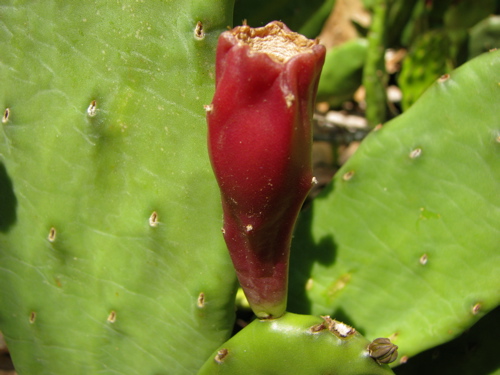Opuntia humifusa
| Habit | cacti-succulent
| |
|---|---|---|
| Lifespan: | ⌛ | perennial |
| Exposure: | ☼ | sun |
|---|---|---|
| Water: | ◍ | dry |
| Features: | ✓ | flowers, edible, fruit, drought tolerant |
| Flower features: | ❀ | yellow |
|
Opuntia > |
humifusa > |
Raf. > |
If this plant info box on watering; zones; height; etc. is mostly empty you can click on the edit tab and fill in the blanks!
Eastern Prickly Pear (Opuntia humifusa), also known as Indian fig, is a native cactus found in the northeastern part of North America and is found through New Jersey, New York and the New England states, and even in parts of Eastern Canada, e.g. southern Ontario.
The green stems of this low-growing perennial cactus are flattened and are formed of segments; barbed bristles are found around the surfaces of the segments. The flowers are yellow to gold in color and are found along the margins of mature segments. The flowers are waxy and sometimes have red centers. They measure 4-6 cm wide and bloom in the late spring.
The juicy and edible red fruits measure from 3-5 cm. As the fruit matures, it changes colour from green to red, and often remains on the cactus until the following spring. There are 6 to 33 small, flat, light-colored seeds in each fruit.
This plant is very intolerant of shade. It thrives in full sun and well-drained soil.
Some botanists treat this cactus as a variety Opuntia compressa var. humifusa, or a synonym of Opuntia compressa. Those recognising this species treat Opuntia rafinesquii as a junior synonym.
Read about Opuntia humifusa in the Standard Cyclopedia of Horticulture
|
|---|
|
Opuntia humifusa, Raf. (O. Rafinesquii. Engelm. O. mesacantha, Raf.). A wide-spreading, prostrate plant, freely rooting from the lower margin of the joints, roots sometimes tuberous: joints obovate to orbicular, usually 2-5 in. long and 2-4 in. wide, sometimes twice as large, dark to light green: areoles with gray wool and bright reddish brown bristles; spines sometimes wanting, when present 1-3 and mostly marginal, stout, 1 in. long, white with darker tips and bases, frequently 1-3 small secondary spines also present: fls. 3 in. or less diam., golden yellow, frequently with reddish center: fr. slender-clavate or broader, 1½-2 in. long, yellowish red to purple, with insipid purplish pulp; seeds comparatively large. W. Cent. U. S.—An exceedingly variable species of wide distribution and imperfectly known. Many varieties have been described, some of which are in the trade. The extreme forms vary greatly from the type. Of these forms vars. Greenii, oplocarpa, cymochila, stenochila and macrorhiza, Hort., have appeared in the trade.
|
Cultivation
Propagation
Pests and diseases
Varieties
Gallery
- Opuntia humifusa ottawa il thecoldmidwest.jpg
Eastern Prickly Pear growing wild in northern Illinois
References
- Standard Cyclopedia of Horticulture, by L. H. Bailey, MacMillan Co., 1963
External links
- w:Opuntia humifusa. Some of the material on this page may be from Wikipedia, under the Creative Commons license.
- Opuntia humifusa QR Code (Size 50, 100, 200, 500)


